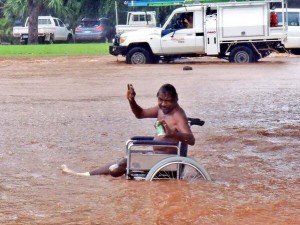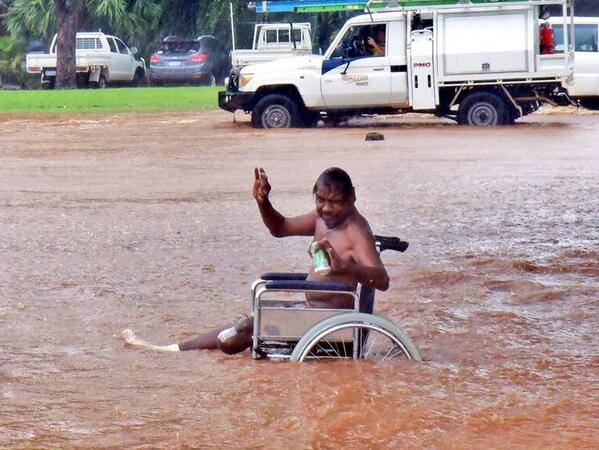
It is important for everyone, especially those with disabilities and other functional needs, to have an emergency plan. Our goal is to empower persons with disabilities and their families to prepare for emergencies. We encourage you to review the information in this section to make a preparedness plan.
Table of Content
- Do & Don’t
- Preparedness Begins with You
- Accessibility Considerations
- Before a Flood
- Create a Support Network
- During a Flood
- for Children with Disabilities or special needs
- If you have a hearing disability
- If you have a Vision disability
- If you have a speech disability
- If you have a mobility disability
- After a Flood
- Emergency Checklist for Persons with Disabilities
- Helpline Number (India)
- State Disaster Management Authority contact details
Do:
- Create an individual emergency plan
- Assemble a “go kit”
- Check accessibility of local shelters
- Keep a portable generator or back-up cell phone battery
Don’t:
- Think it cannot happen to you
- Wait until it is too late
- Leave out those who can assist you in the planning process
- Forget a flashlight, radio, and two routes for evacuation
Preparedness Begins with You
- Your family may not be together when a disaster strikes so it is important to plan in advance:
- How you will get to a safe place?
- How you will contact one another?
- How you will get back together?
- What you will do in different situations?
Accessibility Considerations
- alternate formats
- physical accessibility
- complexity of language used
- auditory descriptions of visual aids
- sign language interpreters
Before a Flood
- Flashlights and extra batteries
- Portable, battery-operated radio and extra batteries
- First aid kit and manual
- Emergency food and water
- Non-electric can opener
- Essential medicines
- Cash and credit cards
- Sturdy shoes
- Power outages could hinder your ability to use medical equipment powered by electricity
- Flooding and debris could prevent caregrivers and emergency workers form reaching you
Create a Support Network
- Provide them copies of your medical and disabilities related info
Have them notify you of hurricane watches and warnings - Familiarize them with your disabilities related equipment, and list any special information and instructions for each.
- Make sure they know where your emergency and medical supplies are located
- Create a network of trusted individuals, such as family, friends, co-workers, personal attendants, etc. who can assist you during an emergency.
- Set up this network at important locations (e.g. home, work, school) making sure you have at least three people at each place. Individuals should take part in your planning and be familiar with your functional abilities and limitations.
During a Flood
- If Indoors: Turn on battery-operated radio or television to get the latest emergency information. Get your preassembled emergency supplies. If told to leave, do so immediately.
- If Outdoors: Climb to high ground and stay there. Avoid walking through any flood waters. If it is moving swiftly, even water 6 inches deep can sweep you off your feet.
for Children with Disabilities or special needs
- Handheld electronic devices with games and/or movies
- A small pop up tent to decrease visual stimulation and offer privacy in a crowded room
- Headphones to decrease auditory simulations
comfort snacks and toys
If you have a hearing disability:
- Pack extra batteries for hearing aids
- Sign up for social media alerts on your mobile device to receive emergency information
If you have a Vision disability
- Keep braille communication cards to be able to communicate with first responders
- Label supplies in your emergency kit with braille or large print
If you have a speech disability
- Create laminated cards with pharases and/or pictures to communicate with others
If you have a mobility disability
- If you have a power wheelchair, pack extra batteries
- Pack a patch kit or sealant for flat tires in case you punture your wheelchair tires
- Keep an extra mobility device like a manual wheelchair, cane or walker
- A car battery can charge an electric wheelchair during power outage.
- If someone is helping you shelter because you have a disability, explain how they can best assist you
- Children and adults with autism spectrum disorder may have difficulties with changes in routine—help them anticipate changes,and tell them what might happen. It may be
helpful to use stories.
After a Flood
- Fire hazards
- Broken or leaking gas lines
- Flooded electrical circuits
- Submerged furnaces or electrical appliances
- Flammable or explosive materials coming from upstream
- Throw away food–including canned goods–that has come in contact with flood waters.
- Pump out flooded basements gradually (about one-third of the water per day) to avoid structural damage.
- Service damaged septic tanks, cesspools, pits, and leaching systems as soon as possible.
- Damaged sewage systems are health hazards.
Resource & References
Disaster readiness tips for people mobility disabilities
Preparedness
Mainstreaming Disability disaster risk reduction and training manual(PDF)
– Sathasivam
Enabled.in Team
